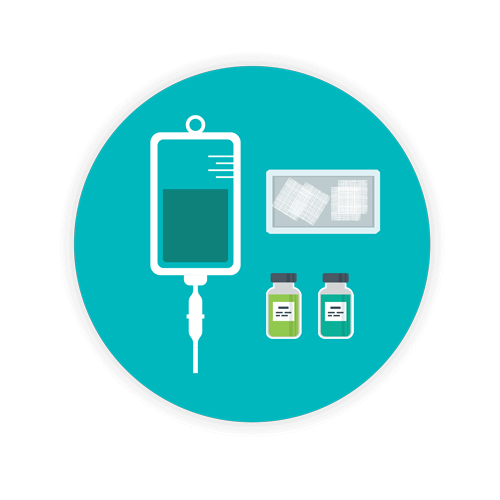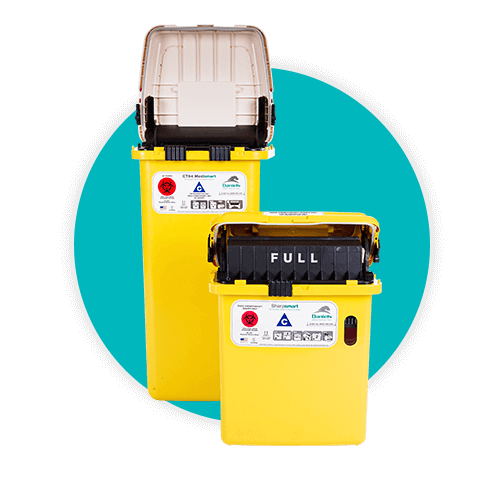10 Things to Consider with Chemotherapy Waste Disposal

Not all waste is handled the same – not even chemo waste. Even an innocent mistake when it comes to disposal of chemotherapy waste can cost a facility tens of thousands of dollars. Per day. Per violation. Are you at risk for penalties imposed for non-compliance? Do you know the rules when it comes to chemo waste disposal?
10 Things to remember when it comes to chemotherapy waste
01 / There’s more than one type of chemotherapy waste.
Chemotherapy waste is typically found on P-lists and U-lists (Commercial chemical products) of substances listed under Resource Conservation and Recovery Act (RCRA) regulations.
02 / Chemotherapy waste will only be considered infectious if it is contaminated with an infectious substance, such as blood.
However, chemo components can be toxic. The Environmental Protection Agency has defined U-Listed chemicals as toxic, and P-Listed chemicals as acutely toxic.
03 / Be aware of the difference between trace and bulk chemotherapy waste.
Chemotherapy waste deemed “trace” can include IV tubing, IV bags, and vials, and which are now termed as “RCRA empty”. Here’s where definitions and interpretations can get a little tricky. Any container that has held a U-listed substance can be defined as RCRA empty when former volume left in the bag or container amounts to less than 3% (see § 261.7 – Residues of Hazardous Waste and Empty Containers as found under the Code of Federal Regulations Title 40 – Protection of the Environment). In such cases, this type of waste can be deemed trace waste and then managed as regulated medical waste as long as it’s disposed of in a compliant and clearly labeled container –in most cases, these containers are yellow. P-Listed waste falls under more stringent regulations and cannot be considered RCRA empty unless a container that once held the waste has been triple rinsed. Keep in mind that P-Listed waste does not fall under the normal RCRA empty rule. Bulk chemo containers can be black and should be considered, handled, and stored as hazardous waste.
04 / Bulk chemotherapy waste can include any container that has held chemotherapy agents.
They don’t qualify under the RCRA empty rules. Additional chemotherapy bulk waste can include any type of material used to clean up the spill or is composed of visibly contaminated personal protective equipment (PPE). Additional examples of bulk chemotherapy waste include full bags or bottles as well as P-listed chemotherapy drugs that fall under RCRA hazardous waste regulations.
Daniels Health is aware that regulations concerning disposal of chemotherapy waste can be confusing. That’s why we offer special chemotherapy waste solutions that ensure compliance. Fines and penalties for noncompliance levied by various agencies can be massive. Daniels Health manufactures clinically engineered and compliant chemotherapy containers in different sizes designed for chemotherapy sharps, trace chemotherapy waste, or larger sizes:

05 / Avoiding cross-contamination or mixing wastes is essential in a healthcare facility.
This also applies to chemotherapy waste, whether you’re an oncology center, a specialty practice, or a hospital.
06 / Federal and state guidelines and regulations state that chemotherapy waste must be processed by incineration treatment only.
Guidelines and regulations also stipulate that only approved collectors and liners are allowed when it comes to disposal and transport.
07 / Become familiar with Federal Code Regulations § 261.3 – Definition of Hazardous Waste.
Yes, it can be overwhelming, but understanding definitions as described by federal and state guidelines is one of the first steps toward maintaining compliance and avoiding costly mistakes.
The following considerations are a result of the new USP 800 standards which are separate from RCRA:

08 / Pay attention to terminology.
Chemotherapy drugs and wastes are also defined as an antineoplastic waste.. Guidelines for proper segregation and disposal of chemotherapy agents is applicable to pharmacies, hospitals, or other healthcare providers. Every state has specific guidelines, and while most follow federal guidelines, state statutes and regulations can also be more stringent than the federal guidelines.
09 / Be aware of the guidelines in regard to the labeling of any type of chemotherapy waste in your state.
The size and placement of labels required by different states must be followed in order to maintain compliance. This is not just applicable to segregating and storing the waste in a facility prior to medical waste disposal by a medical waste business. It also applies to transportation and ultimate disposal of wastes. Numerous governmental agencies will be involved in this process from the EPA to the Drug Enforcement Agency (DEA) to the Department of Transportation (DOT).
10 / Get adequately trained.
Every employee in a healthcare facility that comes into contact with chemotherapy drugs, waste or personal protective equipment (PPE) must be adequately trained in the disposal, handling, and storage of any type of chemotherapy waste.
Conclusion
Information regarding federal regulations for hazardous wastes are found on the website of the Environmental Protection Agency. Laws and regulations, compliance, and enforcement guidelines are readily available. Fines and penalties for noncompliance are levied by the Environmental Protection Agency, but other agencies may also levy fines including noncompliance with transportation guidelines, or potential negative environmental impact as per the Clean Air or Clean Water Acts.
Don’t be caught breaking the rules, which can amount to up to $70,000 per day, per violation imposed by the EPA. Call Daniels Health to help you navigate the guidelines and considerations for chemotherapy disposal.
For more information on the variety of Chemotherapy or Cytotoxic waste solutions Daniels has to offer, see our Chemosmart solutions page here.
Let's Talk!
Your time is valuable, and we don’t want to play hard to get. You can either phone us directly on the details listed on our contact page, or feel free to fill out this short form and one of our team members will get back to you as quickly as possible.
